The personal income & outlays BEA economic report for January 2011 is out. PCE or personal consumption expenditures increased 0.2%. Personal Consumption Expenditures are part of GDP, which had increased 4.1% for Q4. Take away inflation and PCE dropped -0.1%. Real PCE, or consumption adjusted for inflation, is what is used to imply real GDP growth. Today's report has negative implications for Q1 2011 GDP.
Personal income increased 1.0% in January. This is due to tax changes. Take away those tax changes and personal income increased 0.3% in comparison to December 2010. Below is personal income, not adjusted for inflation, or price changes.
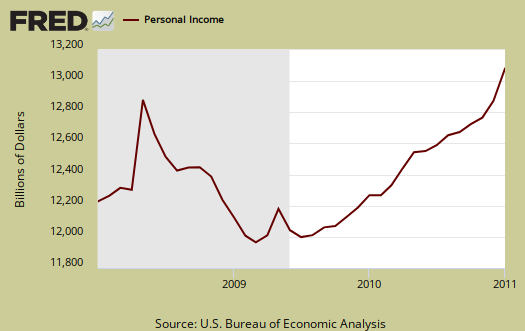
This report notes some tax changes. With all of the claims we must reform social security, below is what Congress actually did, reduced social security payments into the system for workers and the self-employed. They also increased taxes on the poor through the expiration of the Making Work Pay tax credit. Employers social security contribution stays the same, 6.2%, yet starving the social security fund to claim there is a crisis might not be such a good worker deal in the long run.
The January change in disposable personal income (DPI) was affected by two large special factors. Reduced employee contributions for government social insurance, which reflected provisions of the Tax Relief, Unemployment Insurance Reauthorization and Job Creation Act of 2010, boosted personal income in January by reducing the employee social security contribution rates (employee contributions for government social insurance are a subtraction in the calculation of personal income).
The January change in DPI was affected by the expiration of the Making Work Pay provisions of the American Recovery and Reinvestment Act of 2009, which boosted personal current taxes and reduced DPI (personal current taxes are a subtraction in the calculation of DPI). Excluding these two special factors, which are discussed more fully below, DPI increased $11.4 billion, or 0.1 percent, in January, following an increase of $48.5 billion, or 0.4 percent, in December.
Disposable income is what is left over after taxes. DPI or disposable income increased 0.7% for January, but adjusted for inflation, only increased 0.4%. Remember these numbers include income of the uber-rich.
Take away the social security tax holiday and disposable income only increased 0.1%, or personal income total increased 0.3% in comparison to December 2010. Below is disposable personal income minus personal consumption expenditures monthly raw total changes.
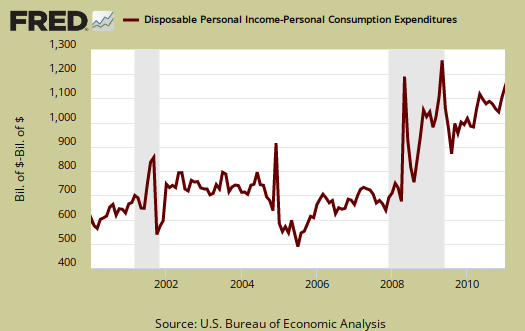
Below is real disposable income per capita. Per capita means evenly distributed per person.
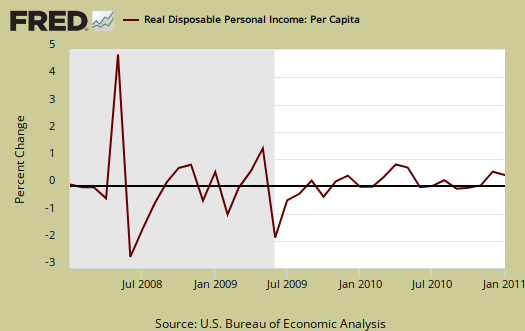
Pretty flat monthly change huh? The population in the U.S. increased 190,000 in January 2011. What sounds really good initially, if one looks at population growth, not so great. The numbers reported in the press headlines are aggregates. Aggregate means everybody, the total.
Personal consumption expenditures is the largest part of GDP, currently 70% of Q4 GDP is from PCE, so a -0.1% real decrease is not good news for economic growth. Below is a graph of real PCE, which is adjusted to not reflect inflation or price changes, in order to show the real economic activity versus the gouging at the checkout line and the pump.
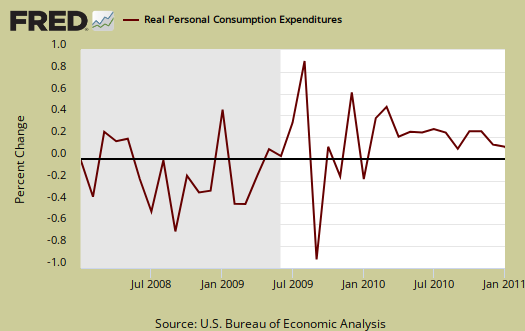
The PCE price index increased 0.3%, but minus energy and food increased 0.1%.
Personal Savings increased to 5.8% to a 5.4% rate of DPI (disposable personal income) for December. This again is a reflection of the social security tax holiday.
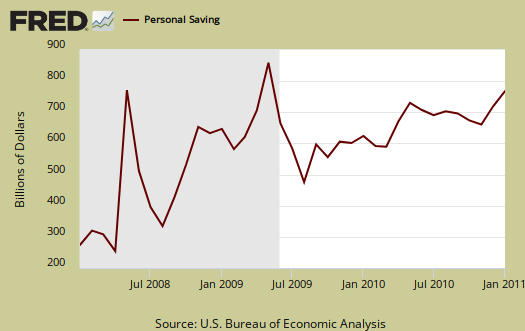
On personal income, wages were flat, a monthly change of 0.3%, the same as December. Below are wages and salaries for the past decade, on aggregate, not adjusted for inflation. What's wrong with this picture?
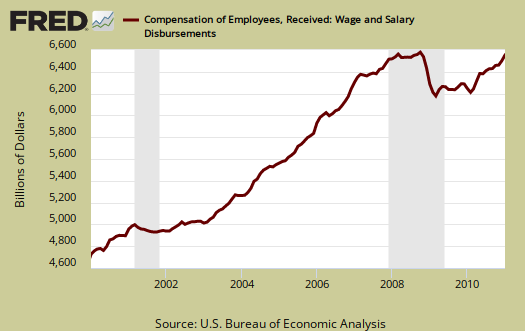
Look at how much the taxes are for the social security fund in 2011, your government at work:
The January decrease in personal contributions for government social insurance reflected the Tax Relief, Unemployment Insurance Reauthorization and Job Creation Act of 2010, which temporarily decreased the social security contribution rate for employees and self-employed workers by 2.0 percentage points for 2011.
Below is personal income minus transfer payments. This graph shows how much personal income increased that wasn't funded by the government. Transfer payments are payment from the government to individuals where no actual services (work) was performed. This includes social security, unemployment insurance, welfare, veterans benefits, Medicaid, Medicare and so on.
Here is what the above numbers do not show, the screw job on the poor, as shown by the spike up in the below graph. The result of allowing the Make Work Pay tax credit to expire, this means the working poor just got a whole lot less money starting in January 2011.
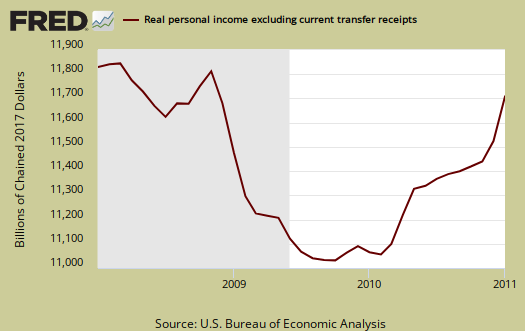
Personal current transfer receipts decreased $11.2 billion, in contrast to an increase of $2.4 billion. The January decrease in personal current transfer receipts reflected a decrease of $8.9 billion to the Earned Income Credit based on federal budget projections.
To visualize more data from this report, consider playing around with more of the St. Louis Federal Reserve Fred graphs.
Here is last month's overview.

Personal Income
There was another interesting statistic from the Personal Income report that was not widely reported (Or at least, I never heard it mentioned.) Wage and Salary Disbursements for January increased $16.8 billion, or only +0.26%.
($16.8 billion ÷ $6,510.9 billion = 0.00258)
Since the BEA's inflation measure increased +0.30%, that means that Real Wages & Salary Disbursements for January DECREASED by -0.04% on annualized basis. So not only did Real Personal Consumption Spending decline -0.1%, but Real Wages & Salaries also declined by -0.04%.
And this is an aggregate amount covering the entire US labor force. Given an annual 0.77% increase in size of the US population, this is a decline of -0.81% in per capita real wages & salary disbursements.
Little wonder that Real PCE's fell by -0.1%
EconomicPopulistForum
Personal Income
Hey unlawful, haven't seen you for awhile. A while since I wrote this up but I think you're right as I recall...
Yeah, squeeze, squeeze, squeeze on the middle class....
show up here more! Very few are paying attention to the stats, monthly, annual economic indicators and could use your observations!